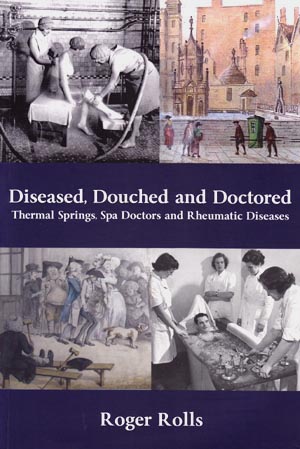
| 
|

 Book Reviews
Book Reviewsby Dr Bruce E Osborne
Roger Rolls (2012) Diseased, Douched and Doctored.
This is a thought-provoking book that solicits the question: is this the record of the demise of a branch of medicine that was once held in great esteem?
The essence of a good book is that it produces new observations and findings rather than just regurgitates the writings of others. Achieving this entails original research using archive documents, field work, archaeology, etc. Roger Rolls' new book achieves this and thus extends the scope of our understanding of the application of thermal waters for health, particularly at
Dr. Roger Rolls, as a medical historian, was particularly active during the 1990s with the British Spas Federation, promoting well-being through the application of spa waters. This era was decisive for the spa industry, laying the foundation for the 21st century spa revival in the
Diseased, Douched and Doctors traces the utilisation of thermal spring waters for healing since the Romans, concentrating on the 17th to 19th century period when spas as a branch of medicine were in their heyday. It focuses on the waters of
The changing fashion for different treatments is apparent, particularly as new technologies become available such as electricity. The case is cited of the pioneering use of electricity for healing at Worcester Cathedral in the 18th century. 'Perhaps it was the ethereal quality of electricity which rendered it attractive to ministers of religion' .(page 47) Such practices were readily integrated into the range of treatments available for 'the cure' at
In spite of enthusiasm for new gadgets, important research opportunities were missed. The Bath Mineral Water Hospital was noted for its treatment of rheumatism, one of the long lasting conditions that had defied the other two main areas of medicine historically, the surgeon's knife and drugs. In spite of the high number of patients, little innovation was apparent over the years at Bath, leaving the way open for the other alternatives to develop effective treatments. Prevention also challenged Bath's cure regimes. Lead poisoning was effectively treated at
When reading the book and comparing England with European spas where medical treatments are still practiced, one can not help wondering if we have missed an opportunity for mineral water cure development, especially as it is less invasive than drugs or less irreversible than the knife? In
For anyone interested in the history of medicine or the use of source waters, this book is a must that will extend their understanding of the history and development of a branch of medicine that has all but disappeared in England.
SUPPLEMENTARY INFORMATION
1) TOPOGRAPHICAL LOCATION:
England
3) INFORMATION CATEGORY:
Springs and Wells General InterestHistory & Heritage


